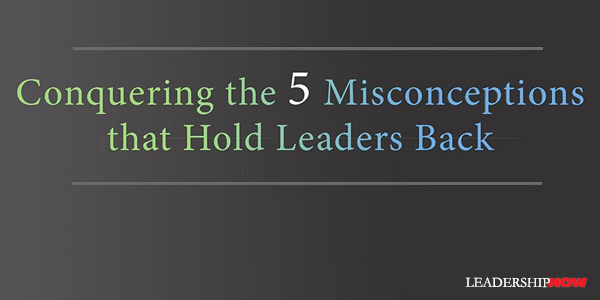 |
 |
01.16.19

Conquering the 5 Misconceptions that Hold Leaders Back
THERE ARE THINGS we believe that when we really think about them, we might find that they are not helpful. We might think of them as blind spots that adversely affect our leadership effectiveness. In What Are Your Blind Spots? Jim Haudan and Rich Berens hope to help you uncover five common leadership blind spots by exposing the underlying assumptions behind the consequences we see played out over and over again in all types of organizations. This is how they lay it out: Leadership Blind Spot #1: Purpose The Misconception: Purpose matters, but it doesn’t drive our numbers. An organization primarily focused on the hitting the numbers is a push mentality. To focus on the purpose is a pull strategy. A firmly ingrained purpose has the power to pull the numbers we are seeking. At the same time, it is nimble and responsive to changing circumstances as it is attached to a point of view and not a procedure. They note: Organizations with a strong purpose at their core are more likely to be able to change when they truly need to. They will view their current operating model and customer offerings as merely a means to achieve their larger purpose and should, therefore, be able to change direction more easily when market forces require a more radical shift. Leadership Blind Spot #2: Story The Misconception: We have a compelling story to tell that people care about. If you have a clear purpose, there is usually a good story behind it. Stephen Denning wrote in Telling Tales, “Analysis might excite the mind, but it hardly offers a route to the heart. And that is where we must go if we are to motivate people not only to take action but to do so with energy and enthusiasm.” The truth is that to reach the heart, you have to create a sense of adventure and a sense of belonging, while also outlining a meaningful journey where people can see how their contributions make a difference. Leadership Blind Spot #3: Engagement The Misconception: Rational and logical presentations engage the hearts and minds of people. We can’t present our way into the hearts and minds of people. The authors suggest that we connect with others with relationships that inspire hope. We contribute disengagement and stifle inspiration. Through authentic conversations, we can co-create with our employees. “We simply suggest,” they write, “that leaders repeat their own personal thinking journey with their people.” Invite people to co-think with you. Inviting your people to help you solve the problems of your business begins with leaders believing in the immense creation capability of their people. Shifting your thinking from “I am the creator, and my people are the implementers” to “I know this business well, but so do my people, and I can learn from them if I really listen” will transform your organization. Leadership Blind Spot #4: Trust The Misconception: People will not do the right thing unless you tell them what to do and hold them accountable to do it. With the first three blind spots exposed and conquered, trust becomes much easier. People know what to do and why they are doing it. Rigid controls are counterproductive, and standards become easier to maintain. They become agents of the vision. To this point: People must believe it’s their store, their hotel, their office, their factory, or their hospital. They must feel that they’re more than a cog in a wheel with overseers watching and waiting to catch them in a screw-up. They note, “It’s the job of the leader to invite that uniqueness to be a part of the work experience every day.” That only happens when we stop controlling our people and trust them and their judgment. Leadership Blind Spot #5: Truth The Misconception: My people feel safe telling me what they really think and feel. I think it is safe to say the people don’t always feel comfortable speaking truth to others especially superiors. For any leader, it’s safer to assume that they don’t and make a conscious effort to create a culture where people will feel safe to come to you with the truth even if it’s just the truth as they see it. Humor helps to break the ice. Truth is a critical blind spot that can create an environment of poor decision making mixed with a significant lack of trust and disengagement in your organization. What Are Your Blind Spots? is a short but well thought out book. Inside you will find an assessment to help you see where you stand on each of these issues as well as exercises and tools to help you conquer each of them. 
Posted by Michael McKinney at 09:56 PM
|
BUILD YOUR KNOWLEDGE
 

How to Do Your Start-Up Right STRAIGHT TALK FOR START-UPS 
Grow Your Leadership Skills NEW AND UPCOMING LEADERSHIP BOOKS 
Leadership Minute BITE-SIZE CONCEPTS YOU CAN CHEW ON 
Classic Leadership Books BOOKS TO READ BEFORE YOU LEAD |